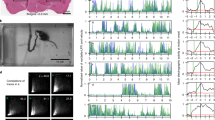Abstract
Previous work from this laboratory has shown that activity in the dorsal spinocerebellar tract (DSCT) relates strongly to global hindlimb kinematics variables during passive displacements of the hindlimb. A linear relationship to limb axis orientation and length variables accounts for most of the response variance for passive limb positioning and movement. Here we extend those observations to more natural movements by examining the information carried by the DSCT during passive stepping movements on a treadmill, and we compare it to information transmitted during passive robot-driven hindlimb movements. Using a principal component analysis approach, we found that a linear relationship between the responses and hindlimb kinematics was comparable across experimental conditions. We also observed systematic non-linearities in this relationship for both types of movement that could be attributed to events corresponding to the touch-down and lift-off phases of the movement. We concluded that proprioceptive information transmitted to the cerebellum by the DSCT during locomotion has at least two major components. One component is associated with limb kinematics (limb orientation) and may be more or less related to the metrics of the step (stride length, for example) or its velocity. The other component is associated with limb length and/or limb loading, and it may signal some aspect of limb stiffness.





Similar content being viewed by others
References
Bosco G, Poppele RE (1999) Low sensitivity of dorsal spinocerebellar neurons to limb movement speed. Exp Brain Res 125:313–322
Bosco G, Poppele RE (2000) Reference frames for spinal proprioception: Kinematics based or kinetics based?. J Neurophysiol 83:2946–2955
Bosco G, Poppele RE (2002) Encoding of hindlimb kinematics by spinocerebellar circuitry. Arch Ital Biol 140:185–192
Bosco G, Poppele RE (2003) Modulation of dorsal spinocerebellar responses to limb movement II Effect of sensory input. J Neurophysiol 90:3372–383
Bosco G, Rankin A, Poppele RE (1996) A representation of passive hindlimb postures in cat spinocerebellar activity. J Neurophysiol 76:715–726
Bosco G, Poppele RE, Eian J (2000) Reference frames for spinal proprioception: limb endpoint based or joint-level based?. J Neurophysiol 83:2931–2945
Chen WJ, Poppele RE (1978) Small-signal analysis of response of mammalian muscle spindles with fusimotor stimulation and a comparison with large-signal responses. J Neurophysiol 41:15–72
Dietz V (2002) Proprioception and locomotor disorders. Nat Rev Neurosci 3(10):781–790
Duysens J, Clarac F, Cruse H (2000) Load-regulating mechanisms in gait and posture: comparative aspects. Physiol Rev 80(1):83–133
Hiebert GW, Pearson KG (1999) Contribution of sensory feedback to the generation of extensor activity during walking in the decerebrate cat. J Neurophysiol 81(2):758–770
Ivanenko YP, Grasso R, Macellari V, Lacquaniti F (2002) Control of foot trajectory in human locomotion: role of ground contact forces in simulated reduced gravity. J Neurophysiol 87(6):3070–3089
Pearson KG (2004) Generating the walking gait: role of sensory feedback. Prog Brain Res 143:123–129
Poppele RE, Bosco G, Rankin AM (2002) Independent representations of limb axis length and orientation in spinocerebellar response components. J Neurophysiol 87:409–422
Poppele RE, Rankin A, Eian J (2003) Dorsal spinocerebellar tract neurons respond to contralateral limb stepping. Exp Brain Res 149:361–370
Saltiel P, Rossignol S (2004) Critical points in the forelimb fictive locomotor cycle and motor coordination: evidence from the effects of tonic proprioceptive perturbations in the cat. J Neurophysiol 92(3):1329–1341
Wilkinson L (1990) The system for statistics Evanston. SYSTAT Inc, Evanston
Acknowledgement
Supported by a grant from the USPHS, NIH grant R01 NS 21143.
Author information
Authors and Affiliations
Corresponding author
Rights and permissions
About this article
Cite this article
Bosco, G., Eian, J. & Poppele, R.E. Kinematic and non-kinematic signals transmitted to the cat cerebellum during passive treadmill stepping. Exp Brain Res 167, 394–403 (2005). https://doi.org/10.1007/s00221-005-0033-y
Received:
Accepted:
Published:
Issue Date:
DOI: https://doi.org/10.1007/s00221-005-0033-y




